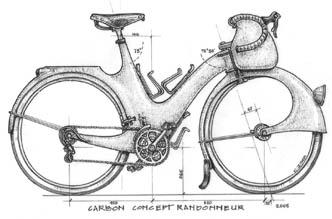A Journey of Discovery, Part 7: The Future

In this series, we have explored how our preferences changed from mid-trail geometries, 700C x 28 mm tires and saddlebags to low-trail 650B bikes with much wider tires and handlebar bags. What will come next? Will we soon ride fully-faired carbon bikes with fenders and racks that form structural parts of the frame (see concept drawing above)?
In the last few years, our preferences haven’t changed further, despite riding very different bikes, like the Moulton with full suspension, the Dursley Pedersen with a hammock seat, and a variety of carbon bikes. Have we arrived at (or rediscovered) something that approaches the ultimate form of the bicycle, at least for the riding we do?
It’s hard to predict the future…
That said, we’ve spend considerable saddle time on more than 50 bikes that cover the available spectrum of bicycles:
- trail figures between 11 and 76 mm
- wheel sizes between 20″ and 27″
- tires between 21 and 42 mm wide
- different suspension systems
- made from the lightest, most flexible tubes you can buy, as well as pretty sturdy and stiff frames
- loads on the front and the rear
- and most possible combinations of these various factors.
While we haven’t ridden recumbents and tricycles, we have studied their performance and found little indication that they would work better for us than the bikes we currently prefer.
It appears that our journey of discovery has arrived at its destination. I am now confident that I can specify a bicycle that will remain close to optimal for a long time, rather than becoming obsolete quickly like the bikes we used to ride. In fact, Mark ordered his “new” bike in 2006. In the five years since, the only things he would change are a slightly lighter tubeset and slightly wider tires. Mark also changed his handlebars to the Rene Herse Randonneur and installed the latest-generation LED headlight, but those were relatively simple modifications. Compare that to the radical changes our bikes underwent in the five years prior.
Of course, everybody’s “ultimate” bicycle will be different. Much depends on where you ride. If your roads are as smooth as glass, then tires wider than 28 mm offer little advantage. If you live in the Atacama Desert, then fenders are of little use, except to protect you from dust.
Some choices are about aesthetics. I like lugs, even though a fillet-brazed or TIG-welded frame can be slightly lighter and easier to adapt to various geometries. (Lugs may be better at distributing stresses, though.) Similarly, narrow tires and racing bikes are aesthetic choices that offer few functional advantages, but that have an appeal of their own.
At Bicycle Quarterly, we try to provide information on how different bicycles perform. With this information, our readers can make informed choices and form their own preferences. What is your “ultimate” bicycle?
Click here to start reading with Part 1 of this series.


